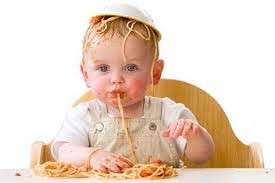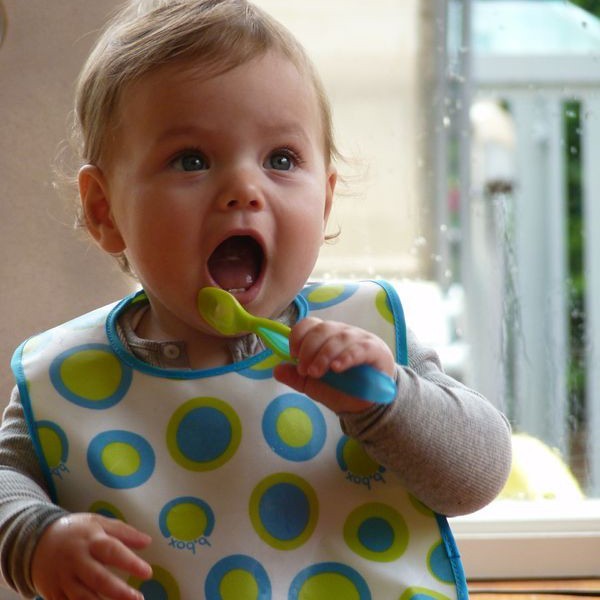View All Blogs

When to
start self-feeding
Months before giving a baby a spoon (which is the
first feeding utensil), let them begin
feeding
themselves with
some soft finger foods, such as a piece of bread roll,
pieces of soft fruit, or rusks, so they can get the feel of picking up food and
directing it to their mouth, which is so important for coordination. Most children will indicate when they are
ready to try on their own. For example, refusing to be fed, or trying to
constantly grasp the spoon away from a parent or carer. At this stage don't
expect baby to truly be able to feed themselves once you give them a spoon. Typically,
at around 7 months of age, a baby should be able to handle a spoon, but
remember
every child is different and
learns at their own pace, in their own way- I remember my son at 6 months
grabbed my glass of water and just started drinking from it. No sippy cup,
training cup, straw cup, toddler cup, or cup with handles was necessary for him
- although we did go through a few glasses!
Self-feeding
is a slow process. It can take months before a baby eats a significant amount
on their own. In fact, by 15 months of age, typically about half of all infants
spill just less than half the food they attempt to get into their mouths.
However, by age 2, children should be able to do most of the feeding themselves
successfully.
What to
expect
Mess. Children experiment with their surroundings,
including food, which is normal. They will want to experience and experiment
with textures -squashing food everywhere, wiping food on the table, banging food
and utensils on the table, dropping everything on the floor, chewing and
spitting, oh, and the occasional successful eating (chewing
and swallowing). This vision leaves many
parents like myself cold, especially if you like your home neat and tidy!
How to
prepare
Food Mat
A feeding mat under a baby's high chair acts like a drop sheet for spills. Try the Heinz Baby Basics Mat or Mother's Choice Lollipop Messy Mat.
Age appropriate cutlery and feeding utensils
When learning to self-feed for the first time, about the only utensil needed is a feeding spoon big enough and deep enough to hold a reasonable amount of food (don't confuse these spoons with weaning spoons, which are smaller and designed for use by a parent or carer). Also, it helps if the handle is child friendly for a good grip and there is a soft tip to be gentle on a delicate mouth and gums. Most baby brands have feeding spoons, such as Closer To Nature Explora 5 Feeding Spoons, Munchkin Soft-Tip Infant Spoons or Silicone Spoons and Heinz Baby Basics First Feeding Spoons. An infant generally starts using a fork and spoon from around 12 months of age when appropriate food starts getting chunkier, like the AVENT Truman Toddler Fork & Spoon or AVENT Truman Travel Case with Toddler Fork & Spoon, while a full cutlery set of fork, knife and spoon would be used from around 18 months of age, when a child has the manual dexterity to use 2 utensils at once and attempt cutting. Try the AVENT Truman Toddler Fork, Knife & Spoon
or Heinz Baby Basics First Cutlery Set.
Suction based bowls and mats
Suction bowls are great, and prevents mealtime
getting out of control (like the picture above).
The Munchkin Super Suction Bowl and Heinz Baby Basics Suction bowl are great solutions, however if you want to use your own bowl, try a suction mat such
as the
Closer to Nature Explora Self Feeding Magic Mat.
Bibs
Bibs are great for catching or slowing down liquids
and food that
don't quite make it into a little mouth. And parents and carers
have so many to choose from. There are
ones made from terry towelling (more absorbent than fleece), such as those in
the large range from
Silly Billyz. This brand also makes great products like
the
Long Sleeved Bib or Messy Eater Bib that are fantastic for eating really messy
foods like mangoes, as they cover sleeves, shirt or dress fronts and are of a
long length.
Bibs are also made of a wipe down material, so they
don't have to be machine washed, which is convenient for travelling. Try the
B.box flat or travel bibs (pictured below), or Closer To Nature Roll 'n Go bib.
If you can't be bothered to wash a bib at all, or it is impractical, there are
a number of disposable bibs available, such as
Gel Pack, Heinz Baby Basics, or Closer To Nature.

Don't Forget!
Try self-feeding with thicker food first so it is easier to scoop up with a spoon (such as oatmeal), be aware of hard food that can be a choking hazard (like raw carrot), and avoid stain-forming food (like mulberries or beetroot) - which make cleaning up impossible, even with the best stain remover.

